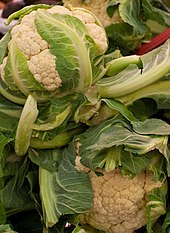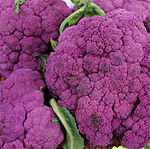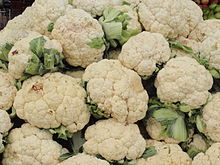 Its name is from Latin caulis (cabbage) and flower, an acknowledgment of its unusual place among a family of food plants which normally produces only leafy greens for eating. Brassica oleracea also includes cabbage, brussels sprouts, kale, broccoli and collard greens, though they are of different cultivar groups.
Its name is from Latin caulis (cabbage) and flower, an acknowledgment of its unusual place among a family of food plants which normally produces only leafy greens for eating. Brassica oleracea also includes cabbage, brussels sprouts, kale, broccoli and collard greens, though they are of different cultivar groups.Botanical varieties
Cauliflower and broccoli are the same species and have very similar structures, though cauliflower replaces the green flower buds with white inflorescence meristem.
Major groups
There are four major groups of cauliflower.
Italian
Northwest European biennial
Used in Europe for winter and early spring harvest. Developed in France in the 19th century. Includes the old cultivars Roscoff and Angers.
Northern European annuals
Used in Europe and North America for summer and fall harvest. Developed in Germany in the 18th century. Includes old cultivars Erfurt and Snowball.
Asian
Tropical cauliflower used in China and India. Developed in India during the 19th century from the now-abandoned Cornish type. Includes old varieties Early Patna and Early Benaras.
Varieties
Self-blanching varieties are 'Self Blanche', 'Early Tuscan', 'Late Tuscan'.
Heirloom varieties include 'All the Year Round', 'Early Pearl', 'Early Snowball', 'Igloo', 'Violetta Italia' and 'Walcheren Winter'. Commercial varieties includue 'Fremont', 'Igloo' and 'Snow Crown'. A comprehensive list of varieties is maintained at North Carolina State University.
Colors
Orange
Orange cauliflower (B. oleracea L. var. botrytis) contains 25 times the level of Vitamin A of white varieties. This trait came from a natural mutant found in a cauliflower field in Canada. Cultivars include 'Cheddar' and 'Orange Bouquet'.
Green
 Green cauliflower of the B. oleracea Botrytis group, is sometimes called broccoflower or brocliflower/broccliflower. It is available both with the normal curd shape and a variant spiky curd called "Romanesco broccoli". Both types have been commercially available in the US and Europe since the early 1990s. Romanesco's head is an example of a fractal image in nature, repeating itself in self-similarity at varying scales. Green curded varieties include 'Alverda', 'Green Goddess' and 'Vorda'. Romanesco varieties include 'Minaret' and 'Veronica'.
Green cauliflower of the B. oleracea Botrytis group, is sometimes called broccoflower or brocliflower/broccliflower. It is available both with the normal curd shape and a variant spiky curd called "Romanesco broccoli". Both types have been commercially available in the US and Europe since the early 1990s. Romanesco's head is an example of a fractal image in nature, repeating itself in self-similarity at varying scales. Green curded varieties include 'Alverda', 'Green Goddess' and 'Vorda'. Romanesco varieties include 'Minaret' and 'Veronica'.Purple
 Purple cauliflower also exists. The purple color is caused by the presence of the antioxidant group anthocyanin, which can also be found in red cabbage and red wine. Varieties include 'Graffiti' and 'Purple Cape'. In Great Britain and southern Italy, a broccoli with tiny flower buds is sold as a vegetable under the name "purple cauliflower". It is not the same as standard cauliflower with a purple curd.
Purple cauliflower also exists. The purple color is caused by the presence of the antioxidant group anthocyanin, which can also be found in red cabbage and red wine. Varieties include 'Graffiti' and 'Purple Cape'. In Great Britain and southern Italy, a broccoli with tiny flower buds is sold as a vegetable under the name "purple cauliflower". It is not the same as standard cauliflower with a purple curd.Nutrition
Cauliflower is low in fat, high in dietary fiber, folate, water and vitamin C, possessing a very high nutritional density. As a member of the brassica family, cauliflower shares with broccoli and cabbage several phytochemicals which are beneficial to human health, including sulforaphane, an anti-cancer compound released when cauliflower is chopped or chewed. Boiling reduces the levels of anti-cancer compounds, with losses of 20–30% after five minutes, 40–50% after ten minutes, and 75% after thirty minutes. However, other preparation methods such as steaming, microwaving, and stir frying had no significant effect on the compounds.
 Along with other brassica vegetables, cauliflower is a source of indole-3-carbinol, a chemical which boosts DNA repair in cells and appears to block the growth of cancer cells. The compound also appears to work as an anti-estrogen, appearing to slow or prevent the growth of tumors of the breast and prostate. Cauliflower also contains other glucosinolates besides sulfurophane, substances which may improve the liver's ability to detoxify carcinogenic substances. A high intake of cauliflower has been found to reduce the risk of aggressive prostate cancer. Cauliflower is also a good source of carotenoids.
Along with other brassica vegetables, cauliflower is a source of indole-3-carbinol, a chemical which boosts DNA repair in cells and appears to block the growth of cancer cells. The compound also appears to work as an anti-estrogen, appearing to slow or prevent the growth of tumors of the breast and prostate. Cauliflower also contains other glucosinolates besides sulfurophane, substances which may improve the liver's ability to detoxify carcinogenic substances. A high intake of cauliflower has been found to reduce the risk of aggressive prostate cancer. Cauliflower is also a good source of carotenoids. Cauliflower can be roasted, boiled, fried, steamed or eaten raw. Steaming or microwaving better preserves anti-cancer compounds than boiling. When cooking, the outer leaves and thick stalks are removed, leaving only the florets. The leaves are also edible, but are most often discarded. The florets should be broken into similar-sized pieces so they are cooked evenly. After eight minutes of steaming, or five minutes of boiling, the florets should be soft, but not mushy (depending on size). Stirring while cooking can break the florets into smaller, uneven pieces. Cauliflower is often served with a cheese sauce, as in the dish cauliflower cheese.
Cauliflower can be roasted, boiled, fried, steamed or eaten raw. Steaming or microwaving better preserves anti-cancer compounds than boiling. When cooking, the outer leaves and thick stalks are removed, leaving only the florets. The leaves are also edible, but are most often discarded. The florets should be broken into similar-sized pieces so they are cooked evenly. After eight minutes of steaming, or five minutes of boiling, the florets should be soft, but not mushy (depending on size). Stirring while cooking can break the florets into smaller, uneven pieces. Cauliflower is often served with a cheese sauce, as in the dish cauliflower cheese.Low carb dieters can use cauliflower as a reasonable substitute for potatoes for while they can produce a similar texture, or mouth feel, they lack the starch of potatoes.
Reference : http://en.wikipedia.org/wiki/Cauliflower










1 comments:
can you give me some seed cauliflower purple for free
icome from indonesia
Post a Comment